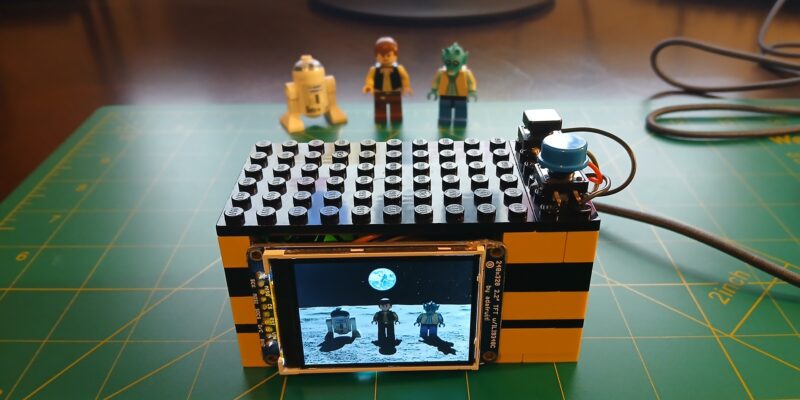Pipistrelle Bat Detector
By Rosie Hattersley. Posted

What bats do in the shadows is quite mysterious, given the challenge of watching the speedy creatures as they flit silently by at dusk. However, their barely-audible-to-humans ultrasonic squeaks can tell those in the know plenty about their movements, moods, and motivations.
Unfortunately, bat detectors cost anywhere from £120 up to £1500+, and devices in the sub-£200 price range are technologically rudimentary, warns Pipistrelle Bat Detector maker Philip Atkin. “They operate like a transistor radio, requiring the user to twiddle a knob to tune into a specific frequency (i.e. a specific bat species), which can lead to frustration as you can miss bats because you are not tuned into the right species.” As the Bat Conservation Trust shows, there are many more species even here in the UK than you might realise.
Advertisement
Christmas is coming – keep Santa on the right track with our Raspberry Pi gift guide!
Phil set about designing a method of detecting bats that did not fall foul of frequency issues. His several decades of coding experience and, in particular, his expertise in music synthesis, proved ideal when it came to designing a low-cost device based around Raspberry Pi Pico.

Tuning in
The first challenge was working out whether there were any bats around. Bats echolocate using ultrasonic frequencies, well beyond human range, but they can’t be heard and are hard to see: “uniquely for mammals, you need technology to detect and study bats,” says Phil. His approach was to have Pico’s sensors scan all the frequencies and seek out the strongest ultrasonic signal. It took him just three weeks to design a Pico-based bat detector that included an operational amp (one which amplifies weak signals), an ultrasonic microphone, a button, and enough software to detect bats and perform speech synthesis.

However, the working prototype board was “an ugly mess and too fragile to take out on surveys,” says Phil, who then turned it into both a printed circuit board and an ultrasonic recorder, adding the ability to record 384kHz/16-bit WAV files to an SD card. This extended the project’s usefulness and meant he could move on to perfecting the surprisingly challenging ultrasonic recording features. Not one to shy away from a technical challenge, Phil chose 128-bit FFTs (fast Fourier transforms) to ensure even the highest frequency bats could be detected. Pico offers exceptional functionality for its size. “Its rich feature set and programmable GPIOs meant that I needed to add the bare minimum of hardware to the design beyond the Pico,” Phil comments “while offering a combination of low cost, low power consumption and the ability to handle 100% duty cycles when processing 128bit FFTs.” This efficiency means Pipistrelle can be used as a passive recorder for four or five nights, “sleeping during the day, listening during the dark, and triggering recordings whenever bat candidate sounds are heard.” These, he likens to music.

“To hear the bats’ true calls – the bird-like whistles, the peeps, chirps, and high-pitched screams of the Horseshoes – is remarkable.”
Double duty
Two years on from his original prototype, there are now three models: BatWalk, a detector to take on bat walks; PippyG ultrasonic recorder; and Pipistrelle itself, which offers both functions. The recorder can either be used manually for on-demand recording, or set to record overnight whenever a bat call is heard. “Overnight recording lets me shut down more of the Pico to get cleaner recordings,” says Phil, an audio purist keen to banish even the slightest operational sounds of the electronics caused by the need to write to the SD card. Each of these can be bought via his Omenie website, and integrated into your bat detection project. A full bill of materials and instructions are provided.

Though he continues to tinker with the audio, Phil finally feels the project is mature enough for someone to potentially create an Android version of it (since the software is open-source) and sees its further potential for studying other ultrasonic creatures, listing cetacean research, since dolphins use ultrasound, along with small mammals and insects.

Subscribe to Raspberry Pi Official Magazine
Save up to 37% off the cover price and get a FREE Raspberry Pi Pico 2 W with a subscription to Raspberry Pi Official Magazine.
More articles
Project Gigapixel
With a medium format 6×7 lens, this camera could theoretically be capable of producing a 3.3 gigapixel image
Read more →

Banamera AI camera
Lego bricks are perfect for prototyping
Read more →

Meet Phil Hutchinson: element14 community organiser
Phil has always been “the technical guy”
Read more →
Sign up to the newsletter
Get every issue delivered directly to your inbox and keep up to date with the latest news, offers, events, and more.

